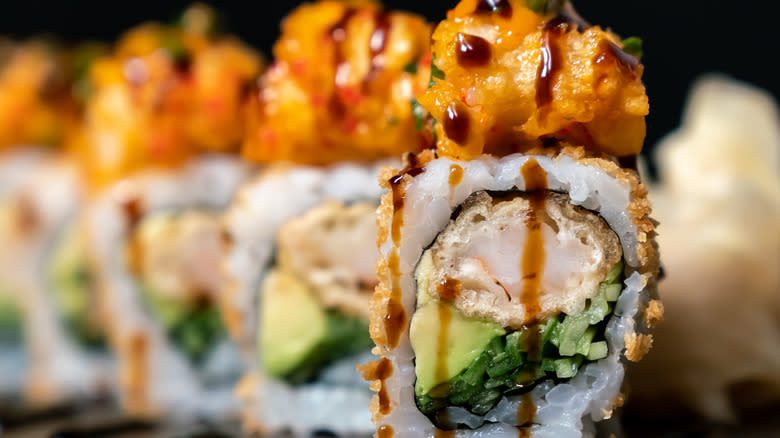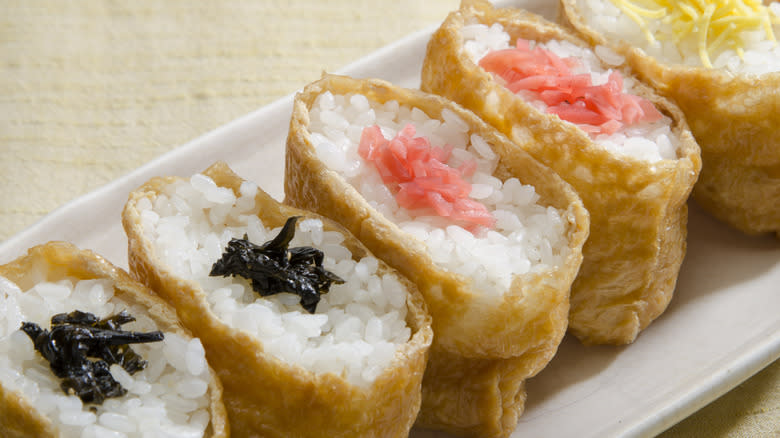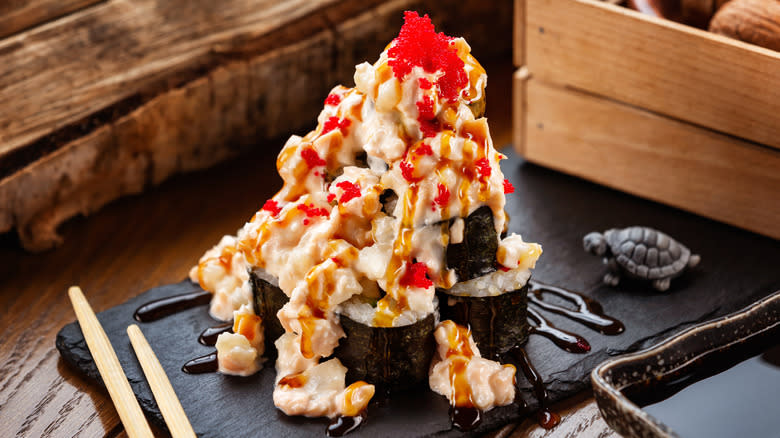16 Types Of Sushi Rolls That Don't Contain Any Raw Fish

Sushi may seem like a one-note dish to some folks, and raw fish in the way of salmon, tuna, squid, and mackerel rolled with nori, seasoned sushi rice, and fresh vegetables may seem the go-to options for those perusing menus at Japanese eateries. But we'd advocate for a bit of diversity in your sushi ingredients beyond the usual rolls highlighting different cuts of raw fish.
Fresh vegetables, tempura crab, shrimp, octopus, eggs, pickled vegetables, and even teriyaki chicken are all as delicious rolled and arranged on your plate with wasabi and soy sauce as the perhaps more familiar spicy tuna or salmon. The good news is that the vast majority of sushi restaurants (at least state-side) serve a vast array of sushi rolls made without raw fish. You can experience the fun and joy of this Far East delicacy with tempura shrimp, creamy avocado, crisp cucumbers, eggs, and even cheese.
Read more: 21 Delicious Ways To Use Up Leftover Rice
Avocado Roll

Avocado rolls frequently dot the menus of sushi restaurants stateside and are deceptively simple in their preparation. Composed of slices of fresh, green avocado, nori, and seasoned rice, this vegan and non-raw-fish roll is a wonderful choice for those looking for a clean-eating and very healthy option or for those searching for a rather neutral, palate-cleansing roll next to more adventurous sashimi or nigiri on the table. In the same way, a lemon sorbet, salad of herbs, or a bit of bread can "restart" your taste buds before moving on to other, more complex sushi; an avocado roll can stand in to bring you back to zero.
Avocado rolls are notably a distinctly American invention. Nearly 50 years ago, a Japanese chef in California was desperately trying to source toro -- the fatty belly portion of tuna -- for his sushi rolls and couldn't get his hands on it. He subbed in avocado, already popular in Mexico, and Americans latched on to the creamy, cool consistency of the fruit in their sushi rolls.
Dragon Roll

The always-artistic dragon roll features a plethora of tastes and textures -- none of which include raw fish. Likely crafted and born out of Los Angeles sushi restaurants circa 1960s, the dragon roll is likely an entirely American invention, focusing on bold but balanced flavors from seafood to fruit to rice.
Described as an inside-out sushi roll (also known as Uramaki), the dragon roll starts with vinegar-seasoned sushi rice, a sheet of nori, tempura shrimp, slices of creamy avocado, and crunchy cucumber rolled together. Then, thin slices of avocado and mango top the roll in an alternative pattern, giving the appearance of a dragon's scales. Rolls are garnished with sriracha mayo and sesame seeds. Preparations can vary depending on the chef, with Mashed reporting that grilled eel, crab sticks, and tobiko can even be swapped in. Regardless of variations, the dragon roll's ultimate goal is to resemble a dragon on the plate, with crisscrossing scales and a slithering swagger.
Spider Roll

If you're squeamish around creepy crawlers or still scarred from that viewing of Arachnophobia, don't worry: The spider roll doesn't contain any 8-legged creatures. The unfortunately-named roll most often contains tempura-fried soft-shell crab, cucumber, avocado, seasoned sushi rice, and nori. The look of the tempura-fried soft-shell crab is how this roll got its name, as the 8-legged ocean dweller does resemble smaller arachnids, and many sushi chefs leave the smaller legs of the crab sticking out from the ends of the roll.
The spider roll is one of the more popular maki rolls ordered at sushi restaurants in the United States, and the ease for chefs to simply deep-fry an entire mid-molt crab makes the spider roll a fan favorite. Variations do abound for this roll, too, with some eateries adding carrots, daikon sprouts, and spicy mayo to the dish. According to The Daily Meal, diners should look for rolls highlighting the freshness of the deep-fried soft-shell crab and not try to cover the taste.
Boston Roll

What the California roll is to the West Coast, the Boston roll is to the East Coast. Featuring poached shrimp, creamy avocado slices, and cucumber, this sushi roll is put together uramaki style -- with the seasoned sushi rice rolled around the crisp sheet of nori. Tobiko (flying fish roe) is pressed around the outside of the roll, giving the entire maki a beautiful flash of red. This special ingredient adds a bit of brininess to an otherwise cooling, light, and healthy roll.
Many folks prefer the Boston roll to the similar California one, which highlights imitation crab instead of poached shrimp. The best part about a Boston roll? It can be easily created at home with a little practice and finesse. A great tip is that after cooking and seasoning your sushi rice, quickly poach some shrimp in a little salt water for a few minutes. Then, slice them thinly, add avocado and cucumber, and roll with nori and the seasoned rice -- with the rice on the outside. Roll the rice side in your tobiko, slice, and serve.
Philadelphia Roll

Home to the Liberty Bell, Rocky, and some truly drool-worthy cheesesteaks, Philadelphia is also the namesake of a delicious raw-fish-free sushi roll. Featuring rich smoked salmon, cream cheese, nori, seasoned sushi rice, and cucumbers, this uramaki-style roll was -- allegedly -- created in the city it was named for. According to the South China Morning Post, the inventor of the roll was one Madame Saito, who taught sushi-focused classes at Temple University in the City of Brotherly Love circa 1980, owned and operated a sushi restaurant. She invented the roll in 1984 after being inspired by a dinner with a Jewish customer featuring smoked salmon and the famous Philadelphia Cream Cheese.
Saito -- the "Queen of Sushi" -- still operates her restaurant, Tokio Headhouse, in Philadelphia today, where guests can snag the beloved roll. To make it at home, simply grab the best quality smoked salmon you can and a bit of that famous cream cheese, plus, of course, your nori, cucumbers, and seasoned sushi rice.
California Roll

Is there anyone in the sushi-eating world who isn't familiar with the California roll? The popular roll is most people's gateway into the realm of maki, handrolls, and the like, and is commonplace everywhere from fine American sushi restaurants to college cafeterias to -- yes -- gas stations and convenience stores. The roll itself was born in Vancouver, Canada, thanks to chef Hidekazu Tojo, who had just come from Japan. Working in one of the area's Japanese restaurants, Tojo noticed that the French Canadians passing through the eatery's doors would eat teriyaki, tempura, and salad -- but never sushi, which, at that time in the 1970s, really only contained raw fish. After perusing the offerings at popular local restaurants and getting a feel for what customers enjoyed, Tojo created a roll with boiled local crab, fresh avocado, and the nori instead of a layer of rice -- hidden from view. He garnished the roll with a bit of mayonnaise to make the flavors even more homey and familiar to his diners.
Today, the California roll most often consists of boiled or imitation crab, avocado, nori, rice, and mayonnaise (sometimes spicy, sometimes not), making this an easy roll to replicate in your own kitchen.
Caterpillar Roll

No, the caterpillar roll is not the featured sushi roll on your toddler's fake restaurant menu. It also does not make use of any insects, bugs, or small, crawling things. Rather, this roll is named thus, thanks to its resemblance to our favorite almost-butterfly animal once it's arranged on the plate.
The caterpillar roll, which is incredibly similar to the aforementioned dragon roll, starts with nori and seasoned sushi rice -- inside-out style, or uramaki, with fillings laying directly on the nori and the rice, making up the outer ring. On the nori, slices of crispy cucumber and unagi (eel) are laid, then, once the roll is, well, rolled, thin slices of avocado are placed atop the rice, giving the entire roll a beautiful green layer, hence the name! Some sushi restaurants that feature the caterpillar roll may swap out the unagi with tempura shrimp or even imitation crab sticks due to overfishing concerns. Regardless of the protein inside, however, the caterpillar roll is a wonderful sushi maki for those not looking for raw fish.
Dynamite Roll

Explosive and not-so-traditional, the dynamite roll varies from sushi spot to sushi spot, but some things remain the same. First, the dynamite roll is always composed of rice on the outside, then nori, then fillings, which include crisp spears of cucumber, cooling avocado, and slices of shrimp tempura. Then, once the roll is, well, rolled, it's garnished with masago or tobiko -- basically, just fish roe. Mayonnaise is sometimes added to the inside or outside of the roll, as well. Technically, the roll is a uramaki style, meaning that the rice is hiding the nori.
It's important to note that the dynamite roll can vary quite a bit depending on where you're eating. Some versions do include raw salmon on the outside of the roll, while others use raw mango on the outside. More often, the roll is simply garnished with white and black sesame seeds.
So, why is it called a dynamite roll? According to some sushi chefs, the tail of the poached shrimp is supposed to stick out of one end of the roll, giving it the appearance of a dynamite fuse.
Teriyaki Roll

If you're not a big fan of sushi in general or are trying to introduce the idea to kids or the uninitiated, a roll featuring the fusion of teriyaki chicken, teriyaki beef, teriyaki shrimp plus rice and nori is an excellent ice breaker. You won't find a teriyaki roll pretty much anywhere in Japan, but stateside, it isn't uncommon to see uramaki rolls with sushi rice, nori, teriyaki chicken, teriyaki beef, and or teriyaki shrimp alongside more commonplace rolls, nigiri, and sashimi.
According to the New Zealand Herald, teriyaki chicken rolls helped introduce the idea to spots otherwise not interested in the idea of maki, nigiri, sashimi, and sushi. In the early 90s, the teriyaki chicken roll was introduced to New Zealand residents as a way to ease diners into the idea of sushi by Tokyo Mutual Trading Co's Yoshiharu Takagi and New Zealand resident Nick Katsoulis. The roll stuck, and eventually, entrepreneurs were able to seize on the roll's popularity, greatly expand offerings, and begin sushi restaurant franchises on the island.
Tiger Roll

No tigers were harmed in the making of this uramaki. Put quite simply, a tiger roll is, more or less, a roll featuring tempura fried shrimp plus the usual seasoned sushi rice and nori. The name tiger roll actually comes from the tiger prawns usually used for the dish. Most eateries add avocado and cucumber to the roll, as well. Ask your server to confirm the ingredients before ordering, though. Sushi chefs can easily substitute things like imitation crab or poached shrimp instead of tempura fried shrimp to put their own spin on the roll.
If you're looking to make tiger rolls at home -- and they can be an excellent gateway into sushi for kids -- just a few ingredients can get you going. Start by laying down a sheet of nori on your sushi mat, then spread your layer of seasoned, cooked, and cooled sushi rice. Turn over with the rice side on the mat, then place avocado, cucumber, and shrimp tempura lengthwise on the nori, with the shrimp tail sticking out of the roll. Roll tightly, seal, and serve with wasabi, soy sauce, and pickled ginger.
Vegetable Roll

The humble vegetable sushi roll is exactly what is advertised: A sushi roll featuring any number of vegetables together with rice and nori rolled and served. The sushi roll can be made traditionally -- with nori on the outside -- or in the uramaki style, with rice on the outside and nori inside touching your fillings. In Japan, you wouldn't find many raw vegetable-only rolls, save cucumber maki, which are common. Those simple rolls feature spears of English cucumber amidst the nori and rice, making them a refreshing bite or palate cleanser like the avocado roll.
Other vegetable rolls and vegan sushi offerings can feature spears of carrot, eggplant, marinated watermelon, pickled plums called umeboshi, and oyster mushrooms. Tempura vegetable rolls are also relatively common, with tempura asparagus, broccoli, sweet potatoes, zucchini, squash, and even carrots dotting menus across the U.S. The fried vegetables provide a hearty crunch and are a great way to get your kids to try both sushi and their greens.
Tamago Roll

A tamago roll, or tamagoyaki, is probably one that most of us aren't too familiar with. Tamago or tamagoyaki is a type of Japanese rolled omelet created by constantly folding over very thin layers of cooked egg. The slightly sweet dish is made with eggs, soy, rice vinegar, and sugar and is served either within a roll with sushi rice and nori or as a nigiri, with the sliced tamagoyaki on top of a ball of rice and pressed in. It can be served at any point in the sushi meal but is popular as a sort of dessert or even a palate cleanser.
Interestingly, a tamago roll was not traditionally so much about the dish itself but, rather, was a sign of a well-trained sushi chef. The sushi chef's skills -- called itamae -- were on full display depending on the composition of this sweet and savory omelet. A messy or broken tamagoyaki is a sign of a lack of patience and skill, while a perfectly rolled and layered one would show an accomplished chef who understood the precision and timing it took to perfect the dish.
Unagi Roll

How often have you had eel? Or, rather, the opportunity to have eel at all? Our guess is pretty rarely, but sushi restaurants almost always have this freshwater fish on the menu. Before you throw up your hands about raw eel, rest assured that unagi rolls, which feature eel, always feature the fish cooked. Unagi is a wonderful choice for those who don't want raw fish but are health conscious, as eel is high in minerals, protein, and vitamins.
Unagi is frequently served stateside, while its Japanese equivalent, Anago, is more common overseas. The popularity of unagi does present some sustainability issues, as overfishing becomes a problem, and eel farmers often cannot keep up with demand.
In terms of preparation, unagi is most often filleted and gutted, then basted in unagi sauce, which consists of sugar, soy, sake, and mirin. It's then either steamed or -- more often -- grilled, allowing a layer of smoke to permeate the meat, lending to its unique and delicious flavor.
Inari Roll

Also referred to as Inarizushi, Inari sushi is most often a home-cooked dish; you won't see it on many sushi or Japanese restaurant menus. That's due to it being more of a pocket rather than a traditional sushi maki or uramaki roll. Rather, the inari consists of Aburaage -- a deep-fried tofu skin -- stuffed with seasoned sushi rice studded with black and white sesame seeds. Occasionally, vegetables like mushrooms, carrots, and avocado can be added, as can chicken. These delightful "pockets" are a common children's snack in Japan as they're often prepared to be fairly sweet.
Thankfully for home cooks wanting to try their hand at Inari rolls, these pockets require no rolling -- only stuffing. To make, you'll need to track down some aburaage, which can be found in the freezer section or canned section at most Asian grocery stores. They're pre-marinated, too, so no need to season. Remove them from the can, heat them a bit, then stuff them with cooked and seasoned sushi rice and any other ingredients you'd like -- from poached shrimp to chicken to vegetables.
Volcano Roll

The explosively popular volcano roll is a mainstay on many sushi restaurant menus in the United States, but the beloved roll is often customized by location, which your presiding chef decides. In fact, the only thing that's really consistent about the volcano roll is that it's presented like a volcano -- with rolls stacked atop one another and the higher ones topped with spicy additions, from sriracha mayo shrimp salad to pieces of thinly cut spicy tuna (making this a raw fish roll) to mimic an eruption.
Most often, the base of your volcano will be made up of the common and beloved California roll with imitation crab, sushi rice, nori, avocado, and mayonnaise. Again, if you're dining out and trying to avoid raw fish, ask your server to clarify the fillings in the rolls making up your volcano. Variations, according to Ichi Sushi, can also include a lobster volcano roll, shrimp tempura roll, and even crab salad rolls.
Tako Roll

Octopus may not seem like the automatic go-to for folks looking to avoid raw fish at the sushi bar, but this delicious delicacy is worth trying if you've never taken the plunge before. Tako is boiled octopus, cuttlefish, or squid, which is then thinly sliced and added to either nigiri or sashimi -- less often to uramaki or maki rolls, although restaurants may differ in its presentation.
Tako is a hallmark of a chef's ability to coax flavor and present a delicious ingredient since octopus is notoriously tricky to master in terms of cooking. First, octopus takes time to tenderize. According to The Japanese Bar, infamous sushi Chef Jiro Ono will massage raw octopus for upwards of 40 minutes before it's added to boiling water to remove the sliminess of the sea creature. After being boiled, the octopus is tender and has an inherent sweetness, making it a lovely foil for sushi rice that's been prepared with traditional rice vinegar.
Read the original article on Tasting Table.
